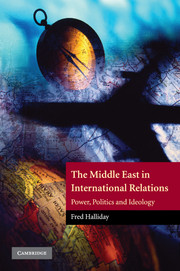Book contents
- Frontmatter
- Contents
- List of maps
- List of tables
- Acknowledgements
- Introduction: world politics, the Middle East and the complexities of area studies
- Part I Concepts, regions and states
- Part II History
- 3 The modern Middle East: state formation and world war
- 4 The Cold War: global conflict, regional upheavals
- 5 After the Cold War: the maturing of the Greater West Asian Crisis
- Part III Analytic issues
- Part IV Conclusion
- Appendices
- Select bibliography
- Index
4 - The Cold War: global conflict, regional upheavals
Published online by Cambridge University Press: 05 September 2012
- Frontmatter
- Contents
- List of maps
- List of tables
- Acknowledgements
- Introduction: world politics, the Middle East and the complexities of area studies
- Part I Concepts, regions and states
- Part II History
- 3 The modern Middle East: state formation and world war
- 4 The Cold War: global conflict, regional upheavals
- 5 After the Cold War: the maturing of the Greater West Asian Crisis
- Part III Analytic issues
- Part IV Conclusion
- Appendices
- Select bibliography
- Index
Summary
Global confrontation, asymmetric interests
The intersection of great power and regional states on one hand, with that of states and social movements on the other, was, therefore, to be dramatically reaffirmed in the Cold War. The Cold War, which lasted from the late 1940s to the end of the 1980s, was a multi-layered competition: while it most evidently did involve wars and military competition between east and west, directly and in support of allies in the Middle East, it also involved more than a mainly military contest, a rivalry for political loyalties and for economic advantage. Yet it is not enough to list this diversity. No international context presents as much analytic challenge as do these four decades of Cold War: here dramatic military crises, protracted inter-state negotiations and upheavals within states, the events of politics itself, were interwoven with a set of less visible, but in the longer run decisive processes, of social, economic and ideological change. The challenge to any analysis of the Cold War is to do justice to both dimensions, relating events and conflicts of the Cold War at the state level to underlying historical and sociological dynamics.
The inter-relationship of these different dimensions was not one of straightforward confrontation between the two blocs as it was in Europe. Rather the Cold War in the Middle East was beset by strategic cross-currents. The United States, for example, had political and strategic interests in Israel, but its main economic interests, in oil, were in the Arabian Peninsula.
- Type
- Chapter
- Information
- The Middle East in International RelationsPower, Politics and Ideology, pp. 97 - 129Publisher: Cambridge University PressPrint publication year: 2005



